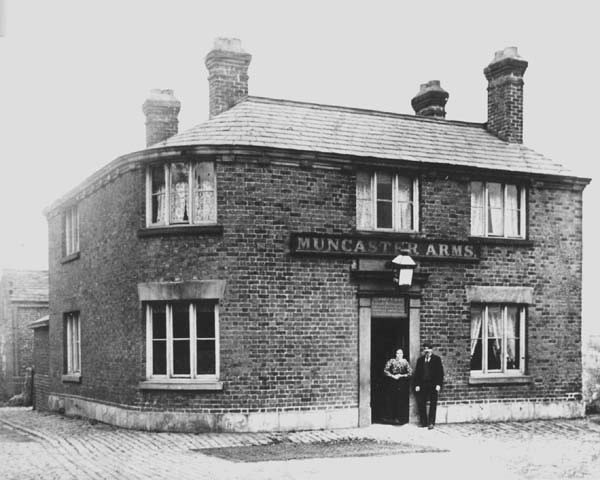
HOTELS / INNS
THE BOTTLE AND GLASS
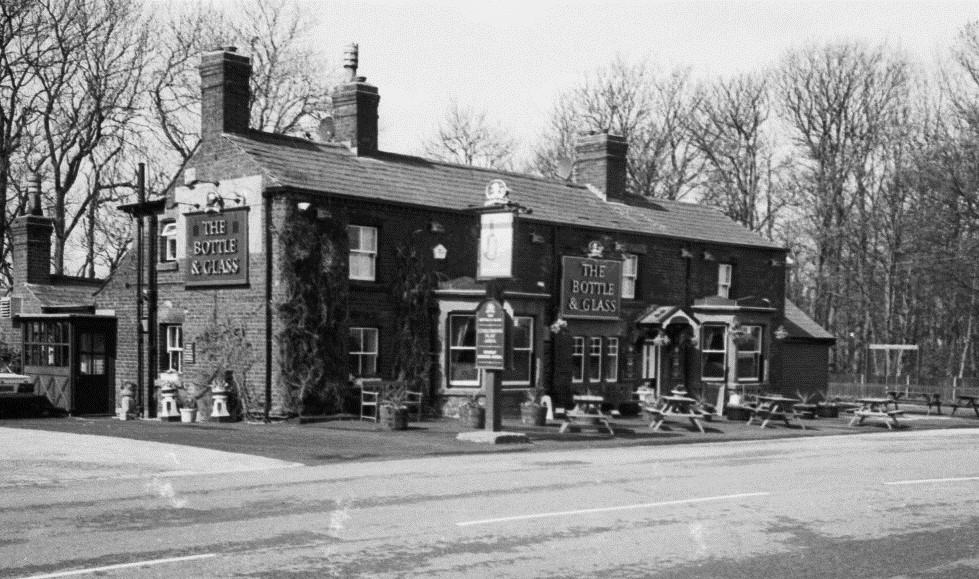
During the 18th century early records indicate Ralph Roughley and his wife Grace occupied the Inn, followed by their son John until 1810 when Thomas Hall became the next tenant. Thomas continued until the early 1820’s when in Baines History and Directory Vol. II.1825 he is recorded as publican of Bowling Green, now known as The Derby Arms.
James Tyrer being the next tenant of the Bottle and Glass was included in the same directory and probably remained at the Inn until William Smith in 1834.
William died on the 11th December 1848 and Ellen, his widow, carried on the business until she died on the 31st December 1851leaving Jane her only unmarried daughter to carry on the trade.
Within three months after her mothers’ death Jane married David Swallow (1817 – 1885), Agent, a new comer to the area and by 1861 David had taken control of both the public house and the clay pipe works next door.
RAINFORD WINDMILL AND MILL HOUSE INN
When James Birch bought the Rookery Farm estate in 1805 there was no windmill or house on the field bordering Pasture Lane. Soon after Birch left to become a brewer, a windmill and millers house were erected about 1820 and these were being occupied by Thomas Allanson in 1821. Within ten years the occupant had become Thomas Fishwick whose father John Fishwick had, since 1810, held the ancient wind and water mills situated by the brook in Mill Lane.
Thomas Fishwick had left Rainford by 1840 when his son James, whose mother had died a few months after his birth, was recorded as living with his grand-parents William and Ellen Smith at the Bottle and Glass Inn.
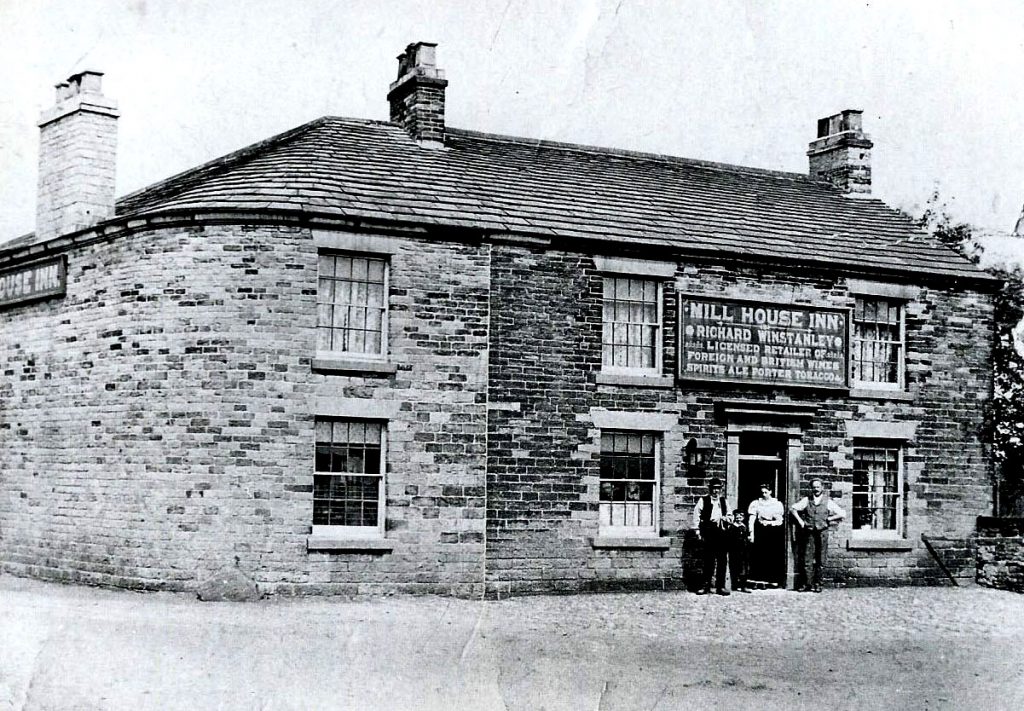
Thomas’s successor at the mill was Charles Ashurst and he is the first to be stated as keeping a beer house there in addition to his farming and milling. Charles, a native of Upholland, was also occupying the fields stretching along the brook behind the mill in 1861 when James Birch’s daughter Mary sold the Rookery estate to Richard Pennington of Muncaster Hall.
Charles Ashurst died in 1870 and in 1871 William Berry had taken his place at the mill. Berry was a young man, born in Newark and was described as a licensed victualler and corn miller occupying the Mill House Inn. The old beer house had become a fully licensed inn, the windmill was nearing the end of its working life and Ashurst’s fields were being farmed by William Green of Rookery Farm. In 1872 Berry built a new steam driven corn mill and house on the west side of Rainford brook near the bridge in Mill Lane where he remained into the early years of the twentieth century.
Following Berry’s departure the windmill at Pasture Lane fell into disuse and was eventually demolished but we know not when. The Mill House Inn remained, was extended and occupied by a succession of landlords including :-
Henry Thomas, George Brown, James Frodsham, Charles Barnes, Richard Winstanley, Richard Kirby
The licence was finally withdrawn in 1936 since when the house has been a private residence.
THE STAR INN
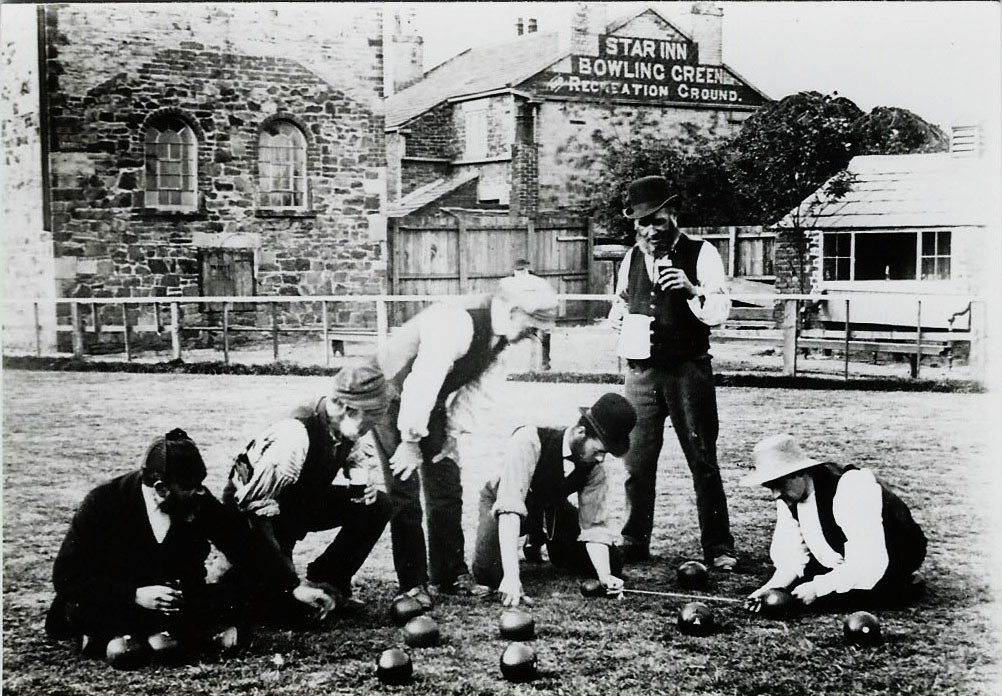
MALT HOUSE IN THE BACKGROUND
In 1831 Richard Durning, Bookeeper born in Liverpool, married Jane Robinson the daughter of the Rev. Matthew Robinson. Richard and Jane had four children Ann 1832, Richard Robinson 1834, Thomas 1836 and Elizabeth 1838.
In 1841, by which time Richard had become a brewer, he was living with his wife Jane and family in Lime Grove (the Avenue). In 1845 Richard built the Star Inn with its own brewery and malt house situated behind.
Sadly by 1861, Richard, Jane, their sons Richard and Thomas and daughter Ann had all died leaving only Elizabeth who went to live in Southport. The Inn has had various landlords and is still popular today but the old malt house was demolished after being put to several different uses during its later life.
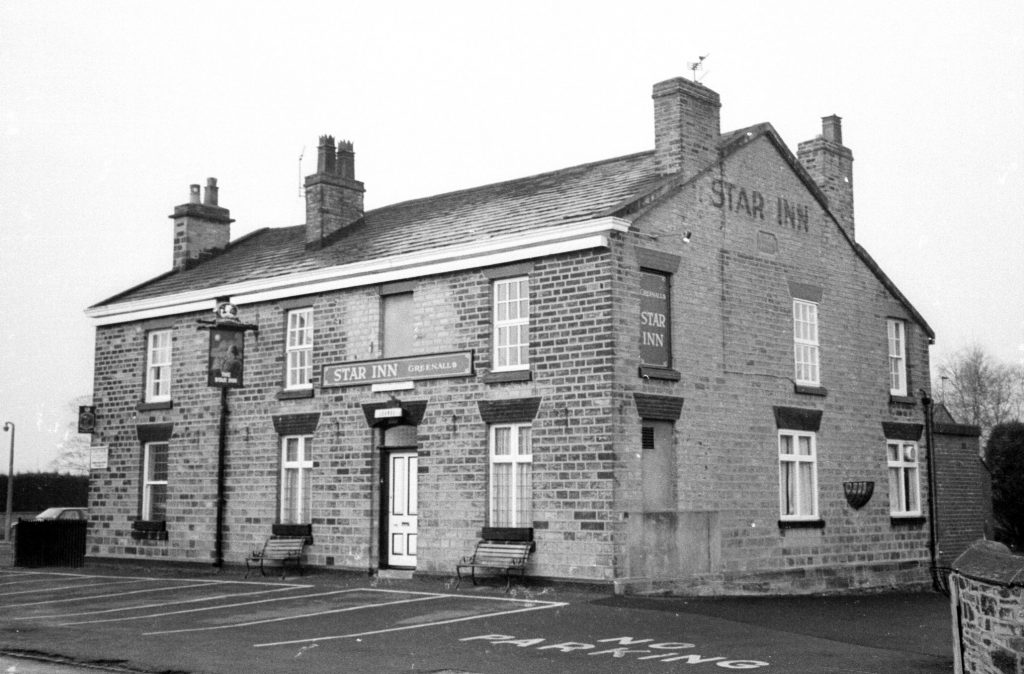
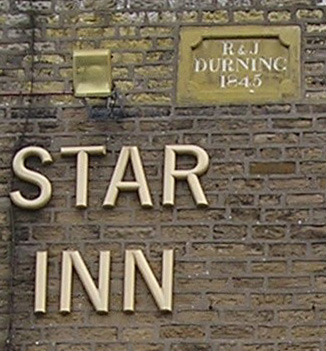
R & J DURNING 1845
NAGS HEAD INN
The Nags Head Inn, originally called the Horse and Jockey and situated at the junction of Rookery Lane and Church Road is where Esther Parkin was known to have been living at some point during her life. In 1851 it was still named Horse and Jockey and Stephen John Langhorn, Beerseller, was the occupier but by 1861 the name had changed to ‘Nags Head Inn’. It remained a public house until finally closing its doors in the 1890’s. Still standing today it has been converted into two private dwellings.
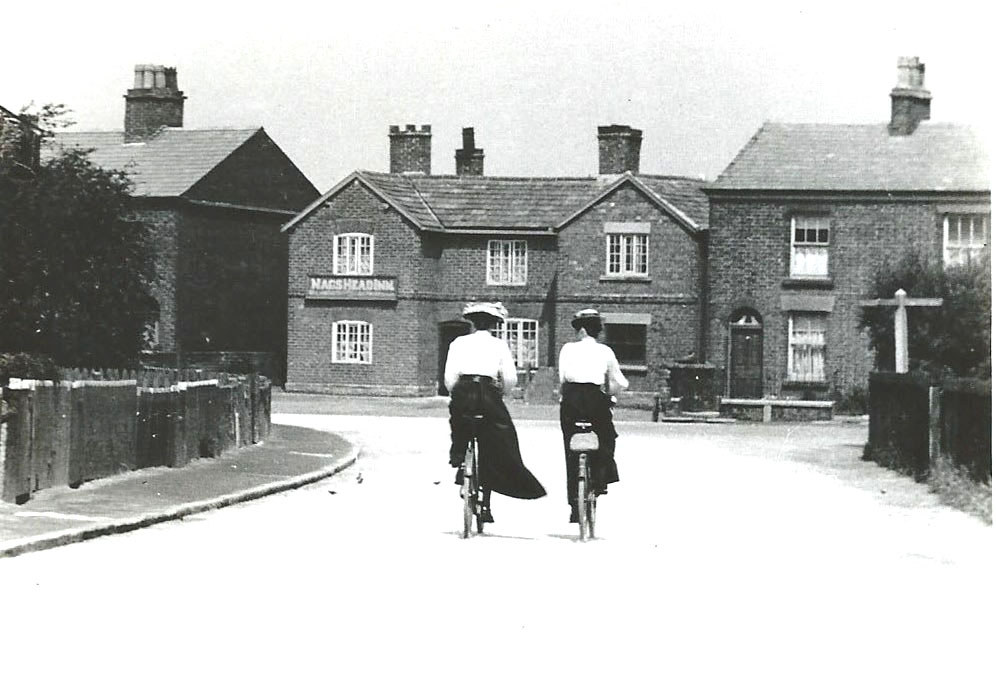
THE DERBY ARMS
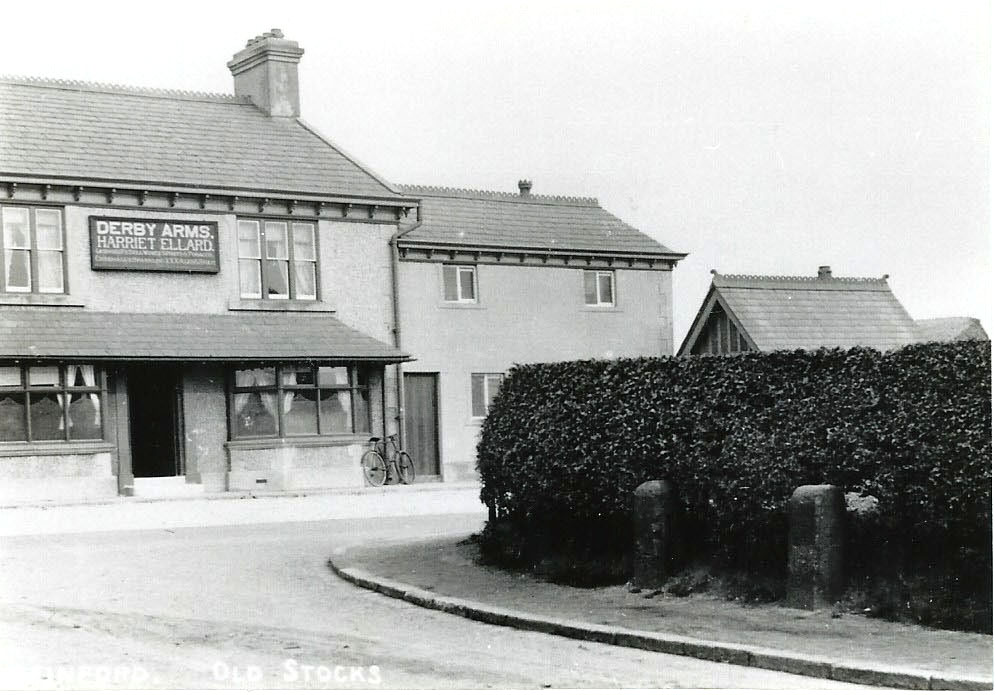
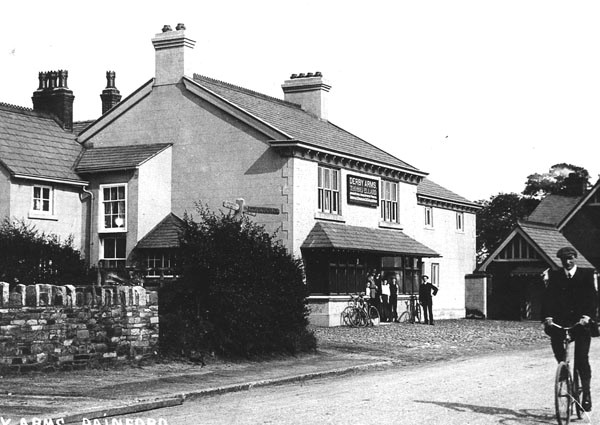
DERBY ARMS
(formerly HORSE STONE HOUSE then BOWLING GREEN)
1662 JOHN BERRINGTON
The Alehouse Returns for Rainford in 1662 name John Berrington without any indication of his place of residence. Fortunately a plan of the Mossborough Estate dated 1666 shows a building opposite the top of Mossborough Road, exactly on the site of the Derby Arms, and beneath it the name Jo: Berrington. There are earlier references to John Berrington’s alehouse in 1630 and again in 1654.
A John Berrington was recorded in the Alehouse Returns as late as 1675 but this is possibly a son of the same name who occupied until the next known lessee took over.
1694 EDWARD RAINFORD
In 1694 Edward Rainford and his wife Margaret leased from Robert Mollineux of Mossborough a dwelling house formerly erected by John Berrington (late father-in-law of the said Edward). In the same year Edward’s name appears in the Alehouse Returns. Edward was over 50 years old when he acquired the licence for this house where he remained until his death in 1730 aged about 86 years.
1725 JOSEPH BROWNBILL
In 1725 Robert Mollineux sold to the Earl of Derby several estates in Rainford including one described as part of a house called horsestone now in the possession of Joseph Brownbill late in the possession of Edward Rainford. In 1731, after the death of Edward Rainford, Joseph also leased the dwelling house mentioned above. Joseph was first described as innkeeper when his son George was baptised at Rainford Chapel in 1726. His wife, Elizabeth, died in 1727 by which time he had also become a malster. Joseph remarried in 1731 to Alice Rainford but in 1738 he died leaving to his only son George Horse Stone House, Kitchen, Cottage, Malt kiln and other Buildings, Yards, Orchards & Backsides thereunto belonging. His will also declared that Peter Rainford never make malt at this Kiln of mine.
As George was only 12 years old at this time we can only assume that his step-mother Alice looked after the public house until he was old enough to take it upon himself.
1747 GEORGE BROWNBILL
Although George Brownbill inherited the premises it is uncertain whether he ever occupied it himself as there is no record of him having been an innkeeper or malster. Without place names it is impossible to speculate which of the innkeepers licensed at this time actually occupied. George and his wife Dulcibella had two daughters, Jane and Dulcibella (see (present) Golden Lion ) and a son William, all still living when George died in 1786.
By 1770 the lease had been assigned to JOHN BIRCHALL a pipe maker of Orretts Nook who was the leaseholder of some sixteen different properties in addition to Orretts Nook. Some of these estates were occupied by his children or grand children (see also Eagle and Child). In 1786 he increased the property by leasing a small plot of adjoining land and forming a bowling green. In his will of 1787 he bequeathed to his son HENRY BIRCHALL his estate called Bowling Green which Henry had been occupying since 1770.
1770 HENRY BIRCHALL
Henry Birchall was recorded in the Alehouse Returns as innkeeper here until at least 1790. In his will of 1803 he directed that Bowling Green, then in the occupation of JOSHUA MOLLINEUX, was to be sold by auction as soon as convenient after his death.
1800 JOSHUA MOLLINEUX
Joshua Mollineux appeared in the Alehouse Returns for 1800. During his time as licensee the premises were sold as directed, the purchasor of the lease being one Mr Bevins of whom we no nothing. By 1810 the tenancy had passed to RICHARD LYON.
1810 RICHARD LYON
Richard Lyon, aged 40, had previously followed the trade of pipemaker and it was only after his marriage to Martha Foster that he became an innkeeper. It was not uncommon for publicans or innkeepers to also continue in some other trade and this may have been the case with Richard for by 1820 he had left the Bowling Green and become a pipe manufacturer employing two apprentices.
1820 ROBERT TYRER
For some unknown reason Robert Tyrer had a very short time here, for in 1822 the tenancy had been taken by THOMAS HALL.
In 1821 Mr Bevins, the leaseholder, was joined by a Mr Robinson, and for some time they were referred to as Robinson & Co. or Robinson & Bevin.
1822 THOMAS HALL
Thomas Hall had been the licensee of the Bottle and Glass since 1810 before coming to the Bowling Green. He combined his trade as a cabinet maker with his duties as publican, no doubt assisted in the latter by his wife Jane. Both Thomas and Jane were natives of Windle and soon after their marriage they came to Rainford where they raised a large family of ten children. Thomas died in 1826 leaving Jane to manage the public house and look after the children.
1826 JANE HALL
Thomas’s widow Jane carried on the business for the next twenty one years, probably the longest tenancy for this house. As the children grew up she would have had some help by her daughters but her two sons both became joiners. Jane died in 1847 at the age of sixty one.
It was probably in the 1830’s that the present building was erected to replace the old house built by John Berrington. When the Population Census was taken in 1841 Jane is shown to be occupying the Derby Arms, the earliest mention of this new name for the inn. Could it have been new building – new name ?
1847 JAMES HALL
James, the son of Thomas and Jane, was the next of this family to hold the licence. Now married to Sarah Lyon he carried out the dual role of joiner and publican for the few years before his death in 1851. They too had a large family but neither Sarah nor any of her sons, who were joiners, plumbers or builders, remained at the pub. Two of James’s sons were married to daughters of WILLIAM GRAYSON who by 1861 had become the next landlord.
1861 WILLIAM GRAYSON
William Grayson, publican and brewer, had previously worked for Richardson’s Brewery at Rainford House, then followed both occupations at the Dog and Partridge in Ormskirk Road. He died a widower in 1868.
In 1869 the freehold reversion of the premises was sold by Lord Derby to Richard Pennington, a cotton mill owner of Hindley who had recently come to Rainford and built Muncaster Hall as his residence.
1869 CHARLES ROBERTS
The census of 1871 reveals Roberts to have been born in West Derby and to be 59 years of age
1875 JOHN PRESCOTT
John Prescott was a former coal miner who came to Rainford from Hindley about 1860 to work in the recently opened colliery at Sidings Lane. After a short tenancy he and his wife Sarah moved to Johnson’s Brow about 1888 where he became a grocer.
1888 THOMAS ELLARD
Thomas Ellard, a native of Wokingham in Berkshire, came to Rainford via St Helens where he had married Harriet. Aged thirty and twenty six with two children they took up the licence of the “Derby” and had seven more children born there.
In 1892 the executors of the late Richard Pennington sold the premises to William Richardson of the Rainford House brewery and the following year Greenall Whitley & Co. Ltd. bought this and several other public houses from Richardson.
Thomas died in 1912 aged fifty four and his widow, with two children still at school, carried on the business until about 1917. Although she left the inn she did not leave the village and was buried in the graveyard in 1935.
Later landords during the 20th century include :-
J. CHARNOCK REG ASHBURNER
WILLIAM LARGE ROY RIGBY
WILLIAM BIRCH KEN GILL
THE OLD GOLDEN LION
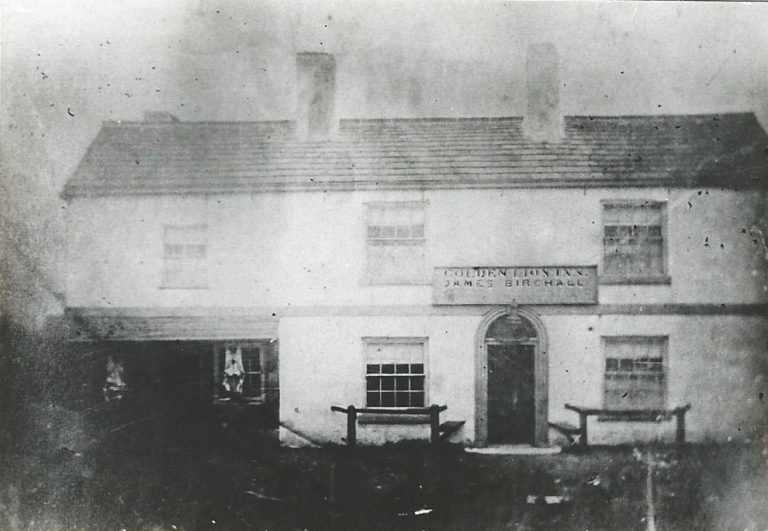
GOLDEN LION ( original )
1663 LAWRENCE GASKELL
In the Alehouse Returns for Rainford in 1675 only two names are given, without any indication of their place of residence. One was John Berrington who is known to have been at the Derby Arms (see Derby Arms); the other was Lawrence Gaskell. In the Returns for 1662 Berrington is listed with MARY MARSH, widow, who was possibly the predecessor of Gaskell. If this is so then this public house could date back to 1630 when a HUMPHREY MARSHE was listed as alehouse keeper.
In the diary of Roger Lowe, a young apprentice mercer of Ashton-in-Makerfield, he records his many visits to various inns and the amount spent there. On a visit to Rainford with two of his friends in January 1663 his diary reads :-
-5 Tusday We went to chappell, to Lawrence Gaskell’s and spent each man 4d. Thence we went to Barringtons and did likewise.
This would conveniently place Gaskell at the site of the old Golden Lion between the Chapel and the Derby Arms.
Furthermore a lease of a cottage and one acre of land was granted to Lawrence Gaskell by the Earl of Derby in 1663. This does not give us sufficient details to establish its whereabouts but does tell us that he had a son JOHN GASKELL.
1710 JOHN GASKELL
In 1710 the lease was renewed to John Gaskell, aged fifty.
1723 ELLEN GASKELL
The same premises, now identifiable as the Golden Lion, were leased in 1723 to Ellen Gaskell, widow. She was presumably the widow of John and may not have been occupying the premises herself as she was described as being of Ormskirk. The next tenant may already have been in occupation at this time.
1728 ELLEN COOKSON
In the annual Rent Rolls due to the Earl of Derby for the year 1728 Ellen Cookson is occupying as a tenant under Ellen Gaskell. The following year the tenant becomes WILLIAM LASSELL.
1729 WILLIAM LASSELL
William Lassell, innkeeper, renewed the lease in September 1731. In another document of 1740 William is described as a butcher and he may have been responsible for the addition of the butcher’s shop which can be seen to the left of the photograph above. William had a long term as landlord of this inn. He was still there in 1758, by then aged 60 years, but when he retired or died is not known.
There now comes a gap of about fifteen years where it has not been possible to confidently associate anyone with this public house
1773 ROBERT BIRCHALL
In the Rent Rolls for 1773 the name JOHN BIRCHALL appears for these premises but the actual occupier is more likely to have been his son Robert. John Birchall was a pipe maker of Orretts Nook and by the time he made his will in 1787 he was the leaseholder of some sixteen different properties in addition to Orretts Nook. Some of these estates were occupied by his children or grand children (see also Derby Arms)
ROBERT BIRCHALL was recorded in the Alehouse Returns from 1780 and by 1800 he is given as occupying the Golden Lion. It was about 1785 when the name Golden Lion first appears
William Lassell’s lease of 1731 expired in September 1778 and in October of the same year it was renewed by John Birchall who bequeathed it to his son Robert in 1787. The property remained with Robert and his wife Esther and when Robert made his will in 1816 he stated that it was in the occupation of JAMES JOHNSON.
1812 JAMES JOHNSON
James, great nephew of Robert Birchall, is not recorded as an innkeeper and it was probably his wife Ellen who looked after the public house.
1820 ELLEN JOHNSON
After the death of her husband in 1820 at the early age of 36 Ellen carried on the licence for at least the next eleven years and appears as such in the Ale House Returns. During her stay here the leasehold of the premises was taken over by JAMES BIRCH who had recently acquired the Brewery at Rainford House from the heirs of William Johnson.
1840 WILLIAM BIRCHALL
William Birchall, son of James & Lydia of Bickerstaffe, was married to Margaret Cook of Prescot in 1833 and described himself as a butcher. By 1840 he was a publican occupying the Golden Lion Inn. They had 11 children before Margaret died in 1856 soon after which William remarried to an Ann.
1869 ANN BIRCHALL
After William’s death his widow Ann continued the innkeeping, the butcher’s shop, and a small farm with five of William’s unmarried children assisting in various departments. Ann died in January 1875 and the licence was granted to her step-son JAMES BIRCHALL who had been her principal assistant in all departments.
1875 JAMES BIRCHALL
James Birchall, aged 40 and now married to Mary, was to be the last publican to occupy these premises. His name appears on the sign board in the only surviving photograph of this inn but he and the sign board were soon to depart.
Early in 1876 meetings were held to discuss the proposal to build a new Parish Church to replace the dilapidated old Chapel and it was agreed to accept Lord Derby’s offer of a site for the new building. This we know was the site of the old Golden Lion. Business was transferred to the present Golden Lion, then known as Alpine House, which stood on the other side of the Chapel. Building work on the new Parish Church commenced in April, 1877, and the 250 year old building was gone for ever.
THE NEW GOLDEN LION
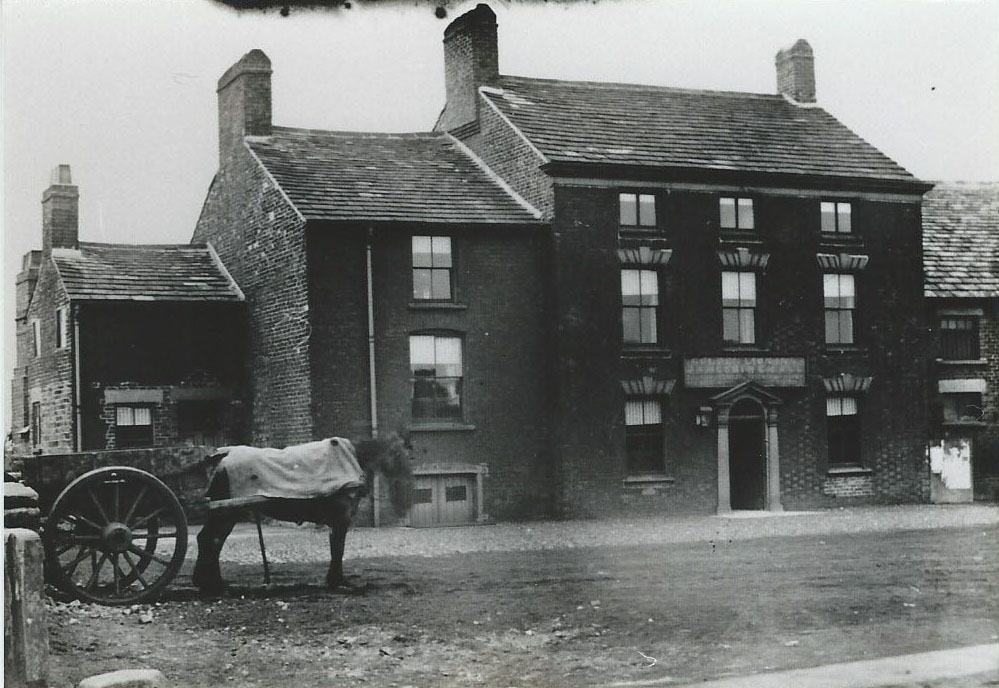
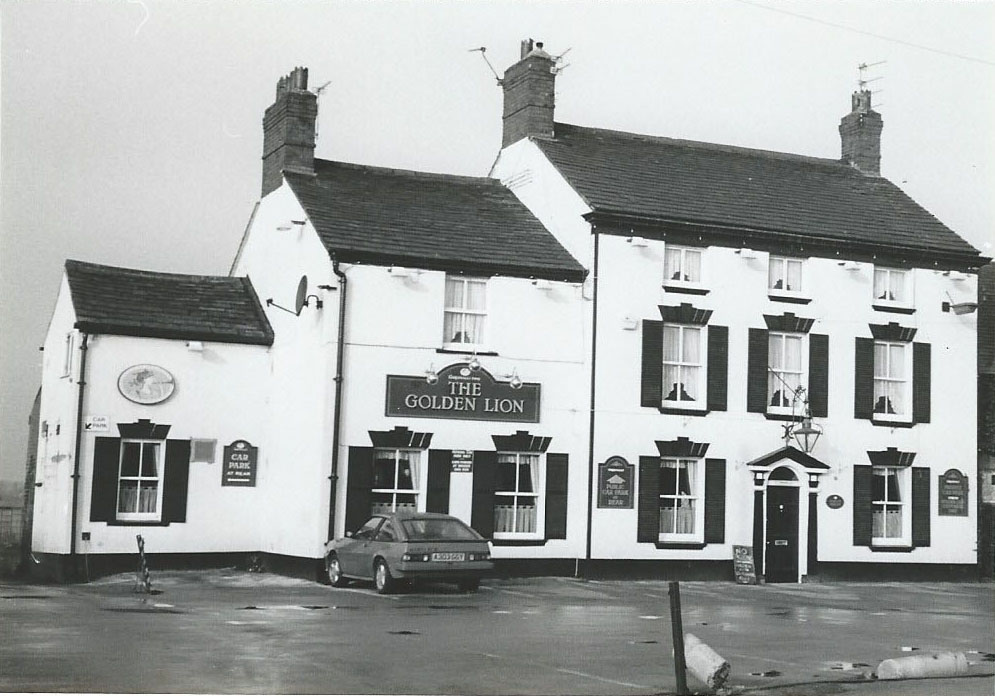
GOLDEN LION ( new )
1687 PETER LYON
The early history of this site goes back to the 17th century when it consisted of a farm house and five fields lying between the main road and the brook totalling approximately eighteen statute acres. It was then in the possession of PETER LYON by a lease of 1687.
1726 THOMAS GROUNDS
The lease was renewed in 1726 to THOMAS GROUNDS of Rainford, yeoman, increased in area to twenty three acres by the addition of three fields belonging to Widow Lyon.
1746 JONATHAN GROUNDS
Thomas Grounds died in 1746 and the farm was inherited by JONATHAN GROUNDS, the eldest of his two sons.
1768 JOHN BRAIN
JOHN BRAIN, a Staffordshire man and innkeeper, first appears in Rainford in 1733 when he and his wife Mary were ordered to appear “for keeping an irregular house on the Sabbath day” In 1751 his wife Mary died and he remarried in 1755 to Susanna Bradley. He was Chapel Warden from 1752 to 55 and when he took an apprentice in 1767 he had become a malster and brewer.
Whether he was occupying this farm house or elsewhere as an inn or where he had his malt house and brewery has not been established but in 1768 he renewed the lease of the “dwelling house out-housing and a cottage with the several parcels of land” formerly held by Jonathan Grounds.
Twelve months later John and Susanna built the grand Georgian building we know as the Golden Lion today. This is attested by the inscription on the front, almost under the eaves.
B
J S
1769
Whether they actually occupied their new house we do not know for in October 1774 John died leaving “sundry lands tenements and premises in the several Townships of Rainford, Upholland and Ormskirk” to his wife Susanna for life and then to his own and his wife’s brothers and sisters. It is possible that the house was then occupied by RICHARD HOLDEN and his wife Esther.
1774 RICHARD HOLDEN
Richard Holden was a schoolmaster and the Liverpool General Advertiser of Decemebr 1769 carried an advertisement for his private boarding school in Castle Street, Liverpool. He came to Rainford sometime shortly before 1774 and opened a similar establishment in the large house so convenient for that purpose. Unfortunately Richard died in January 1775, aged 57, and his gravestone in the Parish Church graveyard tells us that he was Master of the Academy in Rainford. His widow Esther continued with the school, taking day scholars and boarders, she attending to the domestic arrangements and employing the Reverend John Braithwaite, an Anglican clergyman, to conduct their studies.
Following the death of Susanna Brain the leasehold fell to her, and her late husband’s, brothers and sisters and in December 1784 the leasehold of the premises was put up for auction, the highest bid of £405 being made by Mr JOHN HOLDEN who became the next owner.
1785 JOHN HOLDEN
John Holden, son of Richard and Esther, was married to Jane Brownbill the daughter of George and Dulcibella Brownbill licensee of the Bowling Green Inn (now Derby Arms). They had one son, Johnson, and two daughters Jane and Elizabeth. John was described as schoolmaster presumably in charge of tuition at the established Academy. Sadly in less than ten years time both Jane and John had died at the early ages of 25 and 39 respectively, leaving their young children in the care of their grandmother Esther.
1794 ESTHER HOLDEN
Control of the premises now rested with John’s executors until his children became of age. Grandmother Esther occupied until her death in 1800 when their widowed maternal grandmother DULCIBELLA BROWNBILL
1800 DULCIBELLA BROWNBILL
Dulcibella Brownbill then took over the reins for the next ten years followed by her spinster daughter, also DULCIBELLA.
1810 DULCIBELLA BROWNBILL
Johnson Holden became a wine merchant in Liverpool and his two sisters remained unmarried and still living at the house with their aunt Dulcibella until about the 1830’s. It is very probable that the school ceased to exist with the death of John Holden in 1794 as it was not included in a return of schools made in 1825.
c 1835 MARY ROBINSON
The boarding school, now for girls only, appears to have been re-established here by Mary Robinson the daughter of the Rev. Mathew Robinson, late minister at Rainford Chapel. In 1841, assisted by two teachers, she had 16 boarding scholars and possibly day scholars also.
1850 HANNAH PHILIPS
Hannah Philips, one of the assistant teachers, became Mistress of the school after the death of Mary Robinson in 1850. A native of Cornwall, she and her younger sister continued the school until about 1871 but apparently with dwindling numbers of boarding scholars.
In 1871 Elizabeth Holden, the surviving daughter of John, died at the age of 87 and the lease taken out by her father expired. This was possibly the time when JAMES BIRCHALL vacated the original Golden Lion and transferred his licence and his butchers shop to the present building.
1871 JAMES BIRCHALL
James Birchall and his wife Mary took with them the name of their previous inn and were able to adapt the old sign board and set it over the entrance to the new premises. James died in 1887 leaving his widow Mary to carry on the business.
1887 MARY BIRCHALL
With no children to help her Mary successfully ran this large public house alone for over twenty years. She was approaching eighty years of age when she was obliged to retire in 1911 and the licence was then granted to JAMES HALL.
1911 JAMES HALL
James Hall was the grandson of James and Sarah Hall, former licensee of the Derby Arms. When applying for the licence James stated that the licence had been in his family for over 100 years. This was true by virtue of the fact that his father Thomas had married Margaret Birchall the daughter of William Birchall who had held the licence for the original Golden Lion.
James and his wife Willelmina stayed here until he died in 1930 and his wife left soon after. The sudden vacancy was filled by JOHN BALL.
1930 JOHN BALL
John and his wife Sarah retired had retired from the Eagle and Child in 1913 and built a house in Mossborough Road. Sarah died in 1915 and John soon remarried to Mary Wildman. What prompted John to return to the licenced trade at the age of 68 we shall never know. His stay was very short for in July the following year he died.
1931 MARY BALL
John’s widow Mary will be remembered by many older residents as landlady of the “Lion”; as also will her son John, killed in action in 1944. Mary occupied the public house for some 28 years before handing over to the next tenant, THOMAS COWING.
1959 THOMAS COWING
Thomas and his wife were also long term tenants here only relinquishing the licence in 1982, two years after Thomas had died. Since their departure the building has seen much alteration and now boasts an adjoining restaurant, all under a succession of short stay landlords.
THE EAGLE AND CHILD
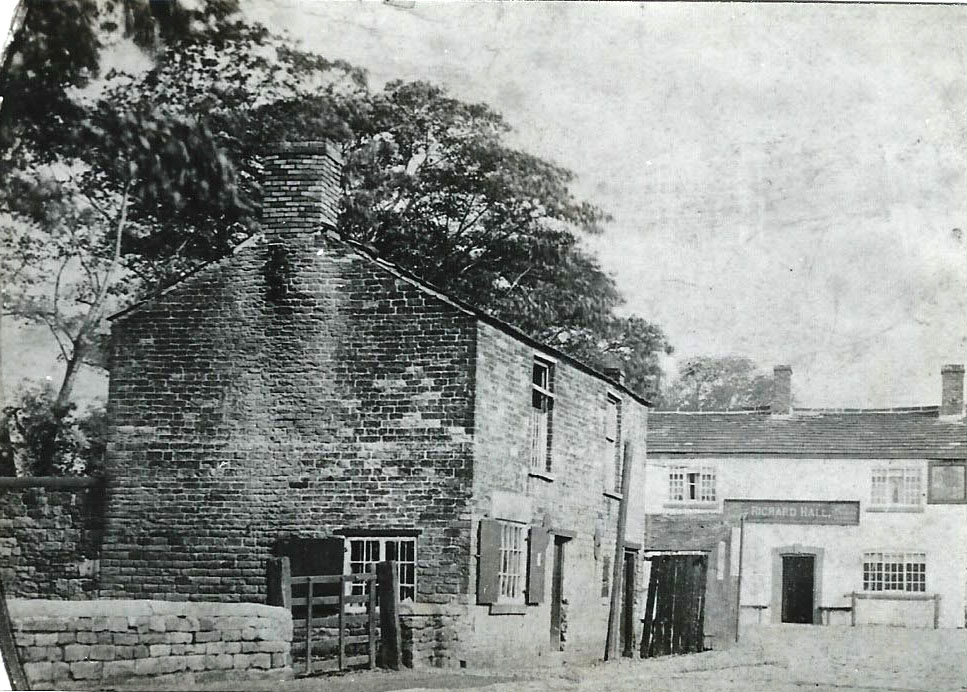
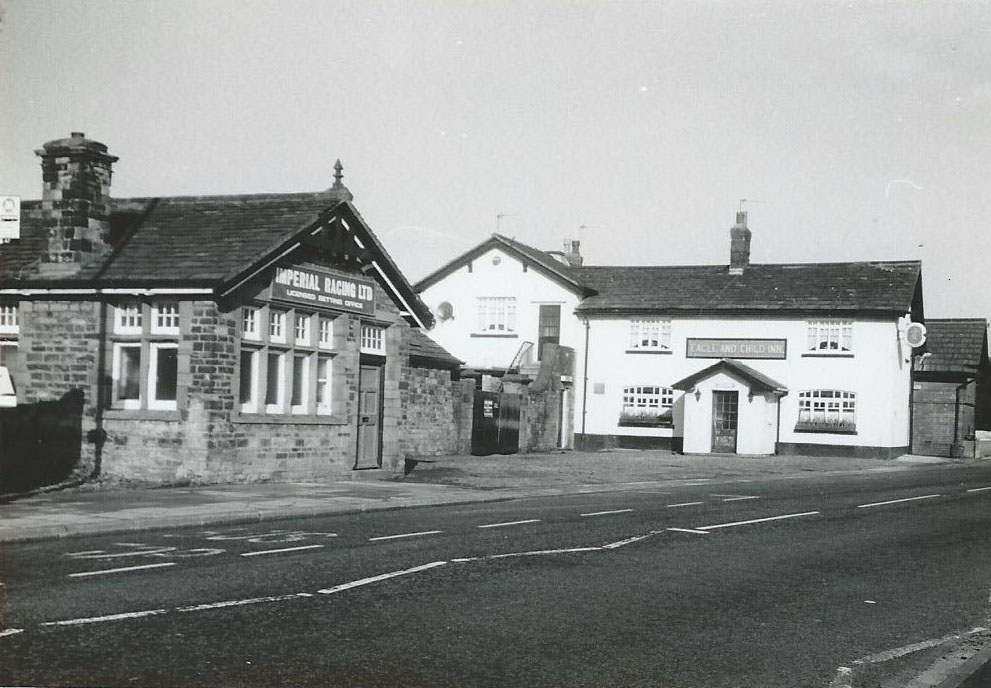
THE OLD BUILDING ON THE LEFT WAS THE FIRST EAGLE AND CHILD. IT WAS REPLACED IN 1904 BY THE PRESENT BETTING OFFICE.
EAGLE & CHILD
1666 HENRY WILSON
Henry Wilson, carpenter, leased an old cottage from the Earl of Derby and in his will of 1701 he left a cottage and shippon with two crofts containing one acre of land to his grandson, also HENRY WILSON.
1707 HENRY WILSON
Henry Wilson junior, innkeeper, came to Rainford with his wife Margaret and four young daughters. He renewed the lease and in 1712 they built a new cottage on the site which became the first Eagle & Child (though not known as this until later). This building can be seen on the photograph above, taken about 1890, and it was replaced in 1904 by the present Betting Office building.
Behind the present sign board lies hidden a date stone salvaged from the old building
W
H M
1712
This stone is the clue to the origin of this public house.
1720 MARGARET WILSON
After the death of Henry his wife Margaret, probably assisted by her daughter Ann, continued the business until she died in 1734
1737 MICHAEL PARR
The next tenant of the house was Michael Parr, innkeeper, who was married to Ann the daughter of Henry & Margaret Wilson. They did not remain long for by 1743 a new tenant had taken over.
1743 HENRY WOODS
Henry Woods, innkeeper, is recorded as paying the annual rental due to the Earl for this property from 1743. He remained in charge for some 25 years and shortly before his death in 1770 his son John appears to have been the landlord here.
1768 JOHN WOODS
John Woods, given as innkeeper at the baptism of his children between 1768 and 1773, had the tenancy until about 1780.
1781 EDMUND BARTON
Edmund Barton, publican, and his wife Elizabeth were possibly the next occupants but this is not certain. They were baptising children here until 1786 when they apparently moved to St. Helens. This was the year when a complete change in the ownership of this inn occurred.
In April 1786 the lease granted in 1707 expired and it was renewed in September by WILLIAM HILL the proprietor of the Dentons Green Brewery in St Helens. He promptly introduced his own tenant to the premises.
1786 RICHARD PINNINGTON
Little is known about Richard Pinington who, although paying the Land Tax on the premises, did not describe himself as innkeeper or publican. Maybe it was his wife who had the running of the pub.
It was about this time that the name Eagle & Child first appears.
1797 JOHN MARQUIS
John & Ellen Marquis were again possibly a husband & wife concern for during their short stay here John was consistently described as a schoolmaster. Whether he ran a small private school here or was the master at Holdens Academy at the present Golden Lion we do not know. They left Rainford about 1802 and removed to Liverpool.
1802 ANDREW VALENTINE
Andrew & Mary Valentine came from Eccleston with two young children to start a tenancy which was to last for over 40 years. They raised seven more children during that time.
At this same time William Hill, the leaseholder, died and in 1821 his son William put the Dentons Green Brewery up for sale together with several public houses in St. Helens and the Eagle & Child and the Bottle & Glass in Rainford. The Brewery was sold to Charles Speakman & Co. of St. Helens but the leaseholds of the two Rainford houses were assigned to JAMES BIRCH of Rainford. Birch had recently taken over the brewery at Rainford House across the road from the Eagle & Child.
1835 MARY VALENTINE
After the death of Andrew, aged 66, in August 1835 his widow Mary was to continue the business for several more years.
It was probably during this period that the present building was erected for by 1840 the old cottage, which had served as a public house for 128 years, was now occupied as a saddler’s workshop by JOHN BALL.
John Ball, a saddler from Upholland, had married Sarah the daughter of Andrew & Mary Valentine in 1838 and they were living in a cottage on Ormskirk Road whilst John was working at the old cottage. This situation soon changed when Mary Valentine died in August 1841.
1841 JOHN BALL
John & Sarah left Ormskirk Road and took up residence in the new Eagle & Child with John, now innkeeper & saddler, continuing his saddlery business and Sarah no doubt running the public house at which she had assisted her mother for so long.
In 1847 James Birch, the brewer and leaseholder of the premises, died leaving his estate to his daughter Mary now married to JOSEPH RICHARDSON. The brewery was to remain with the Richardson family for many years.
After a reign of 22 years which ended with the deaths of both Sarah and John within four months of each other in 1863 the licence fell to Henry, the eldest of their ten children.
1863 HENRY BALL
Just twelve months previous Henry Ball had married Harriet Hall a widow with seven children. Harriet was the daughter of Thomas Birchall licensee of the Stanley Gate in Bickerstaffe and she had married Thomas Hall the son of Thomas Hall licensee of the Derby Arms. She would be no stranger to the workings of a busy inn.
1881 THOMAS HALL
After the death of Henry Ball in 1879 and his wife Harriet in 1881 the licence passed, not to their eldest son John who was only eighteen years old and a saddler but, to Thomas, the eldest son of Harriet’s previous marriage, who was already working at the inn. Thomas died in December 1883 and his youngest brother Richard, aged twenty three, succeeded him in the tenancy.
1883 RICHARD HALL
Richard had previously followed the family occupation as a saddler but was no doubt quite capable of stepping into the position of landlord, a post he held for the next thirteen years.
1896 JOHN BALL
John Ball, the saddler and eldest son of the former licensees Henry & Harriet, was the next member of this family to occupy the premises. He and his wife Sarah remained there until 1913 when they retired to live in Mossborough Road. (see new Golden Lion for the later life of John)
In 1894 the inn was purchased from William Richardson by GREENALL WHITLEY & CO. of the St. Helens Brewery. It was also during this tenancy that the old original buildings were demolished.
1913 WILLIAM THOMAS BALL
On the retirement of John & Sarah his younger brother William Thomas and his wife Elizabeth left the house next door (now Clegg’s Hairdressers and Pimblett’s Cake Shop), which they had built soon after their marriage in 1892, and took over the licence of the inn. His retirement from the position of landlord during the 1930’s brought to an end about 130 years of continuous occupancy by the same family.
Subsequent landlords during the 20th century included :-
THOMAS SLOWEY
HENRY WORTHINGTON
WILLIAM DIXON
ALAN BIRCHALL
THOMAS WRIGHT
BILL ASPINALL
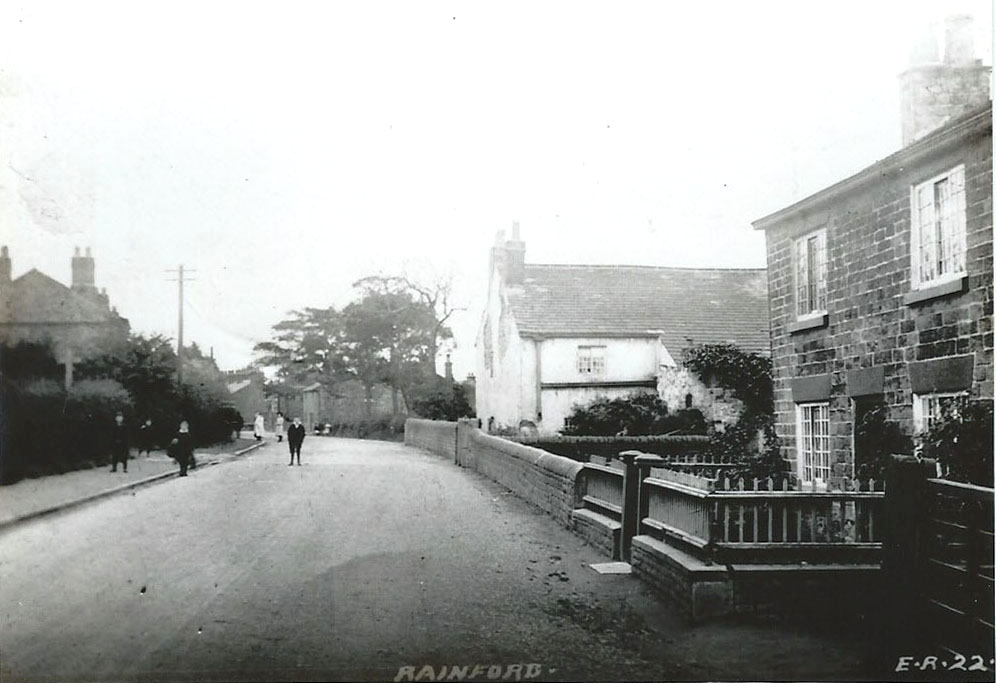
THE DOG AND PARTRIDGE
Recorded as a Beer House in 1825 and known locally as ‘The Old Dog’ it was situated at the junction of Old Lane and Ormskirk Road. In 1911 the large white building was known as Cheapside Farm and occupied by a farm bailiff.
WHEAT SHEAF INN
Known to be the Innkeeper in 1841, John Taylor and his wife Ellen lived at the Wheat Sheaf for quite a number of years. When John died in 1855, Ellen his widow is recorded in 1861, aged 63, as Licensed Victualler. By 1871 James McCone, 54 had become the Innkeeper with Ann Bradley 31, his niece, a Barmaid.
By 1881 Ann Bradley 41 had become the Licensed Victualler. Living with her was her mother Margaret and sister Jane. Ann was followed by her sister Jane who remained Victualler until she died in 1904.
In 1911 John Porter, 33, Licensed Victualler, and his wife Beatrice Annie 25 were living there.
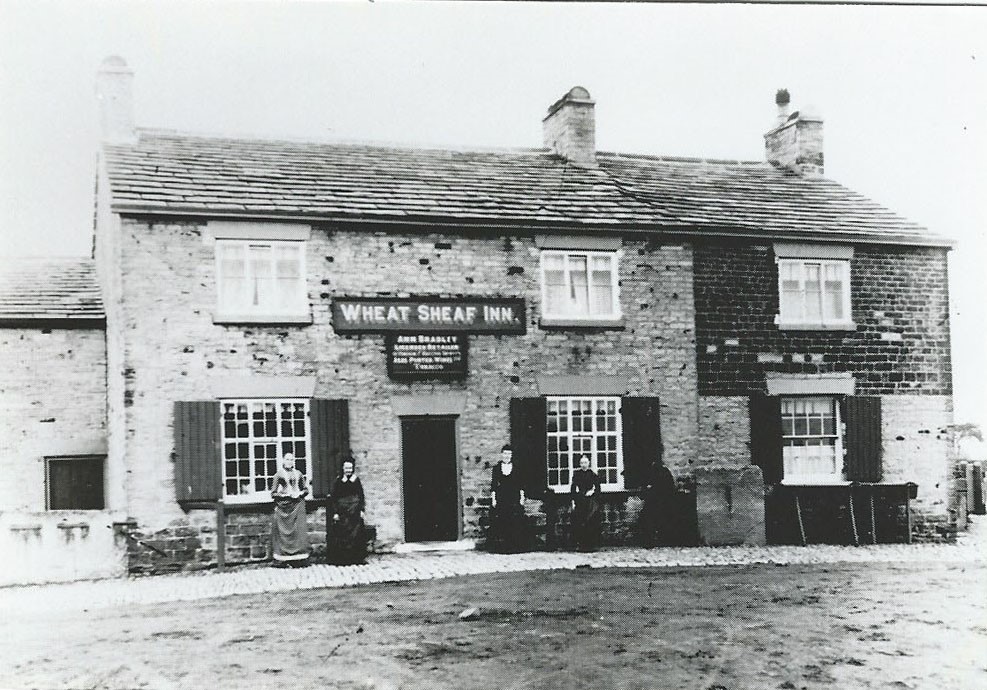
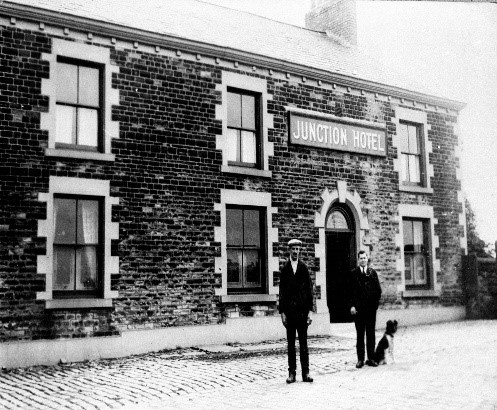
JUNCTION HOTEL
With the coming of the railway, the inevitable hotel soon followed to provide refreshment and rest for the traveller. Built in the 1850’s this one also provided the service of a weighbridge, seen set in the cobble stones behind the gentleman on the left. The gentleman with his dog is licensee James Worthington.
COLLIERS ARMS
The Colliers Arms situated at the junction of Hydes Brow and Old Lane can just be seen at the top right hand corner.
Known to have been a Beerhouse from at least 1861 until it finally closed its doors sometime between 1911 -15 when Henry Worthington and his wife Martha came to live there.
Later it was demolished.
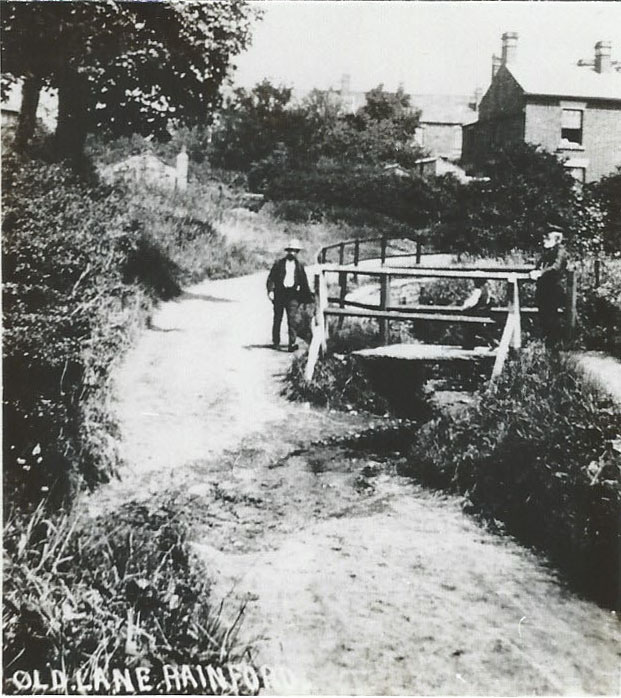
MUNCASTER ARMS
Surrounded by cobbles and a weighbridge was a public house originally called The Maypole. The name was changed to Muncaster Arms after the building of the nearby Muncaster Hall.
No drinks were served here after 1929 when Richard Kirby gave up the licence and he and his wife moved to the Mill House Inn.
